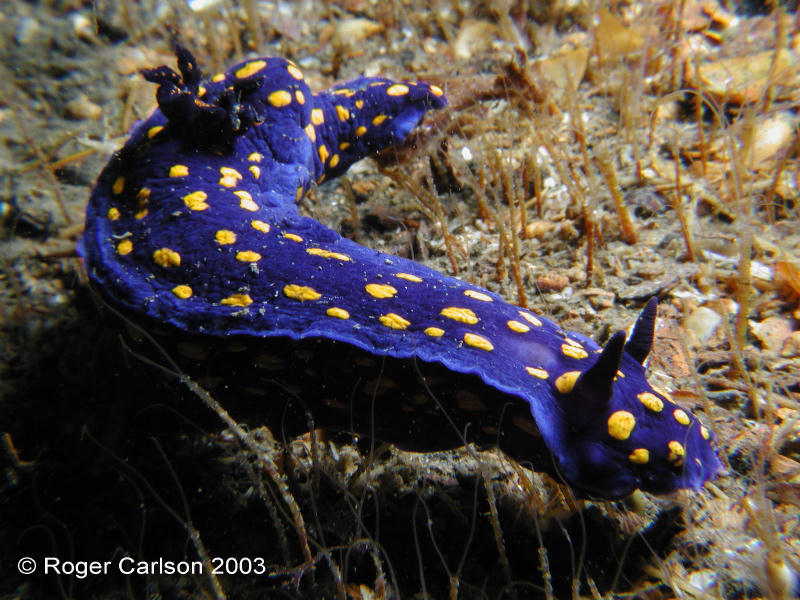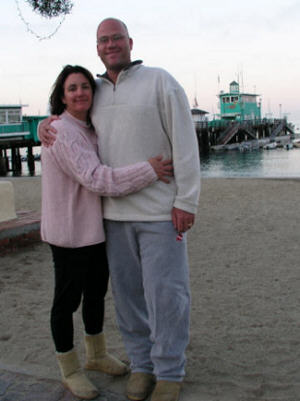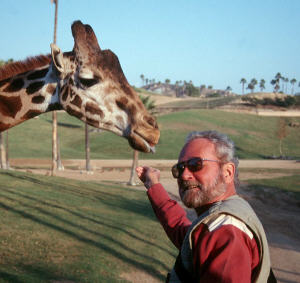 |
Hypselodoris californiensis
Photo Courtesy of Roger and Judy CarlsonWreck of the Valiant
Avalon, Catalina Island
My wife Judy, our friend Jim Lyle, and I, dove the Valiant wreck from the underwater park in Avalon, Catalina Island, California. On our way around the wreck, my wife, who has excellent macro eyes, spotted two nudibranchs on the starboard side of the bow. She showed them to me. I was the only one with a camera, and I took two quick pictures. They were quite large, and not frilly. I thought they were some kind of navanax, nothing special, but Judy knew they were unusual. I couldn't get settled, couldn't take a clear picture, I had a macro lens on and the animals were too big for it (5 or 6 inches), it was dark, it was cold, I gave up pretty quickly and kept going. When we got back, we described them to Jim, and he agreed that it was something he'd never seen.
I shoot digital and we had a laptop with us, so I knew that night that I had taken lousy pictures. The next day, I went back and tried to find the Valiant, but couldn't find it and gave up. The day before was my first dive on it.
Out of curiosity, I posted those original blurry pictures on the web, and got an immediate response from John Moore (creator of Divebums and administrator of the Divebums San Diego e-mail list, list@divebums.com) , among others: We're pretty avid divers, and we've found some strange stuff before that we've tried to get id'd by biologists, like a 1" batfish in Cozumel:
My wife has great macro eyes, and nudibranchs are among her favorite creatures. We're fans of the slugsite, so when Dave and others told us this was a rare beast, we made plans to get back over there. It wasn't much trouble to talk our friends Scott & Margaret Webb into taking us over on their boat last sunday, two weeks after we'd seen it. My wife (and Jim) are so good at spotting stuff that I was pretty confident we'd find them.
It was pretty quiet at the island, the harbor patrol gave us the mooring right next to the Valiant, and had the permission forms on board. It was really easy.
On the first dive, no luck. We covered the wreck, looked all over the bow, inside and out. Lots of Mexichromis, lots of Limbaughs' cadlinas, but that was it. Three divers came through while we were on the wreck. They had swum over from the park, as we had the week before. Two surfaced shortly after we did, looking for the third, and we saw no bubbles. I was not initially concerned. I thought they were from a nearby boat, but I didn't realize they were from the park until later. Anyway, one of them, and instructor, had us call the harbor patrol, and we suddenly realized the situation was serious. Vis was reasonable, so a few of us started snorkeling, looking for yellow fins. The instructor dove back to the wreck, and a sheriff's boat showed up very quickly and started talking with us. Within minutes, a lifeguard boat was there, with a dressed diver, and he went in. Shortly after that, as people were sorting out the name of the missing diver, emergency personnel at the park reported that he was on shore there, and everything was fine. It took a while for us all to settle down. I'll never dive the park again without registering with the harbor master. That form isn't much work, and these guys work so hard in emergencies that if a little form will help them, I'm happy to do it.
We were a little disappointed (but not shocked) at not finding the nudibranchs, and conditions were good, though cold, so we chose to do the Valiant again. Judy and I described the beasts again, size and location.
Jim was first down by a few minutes, and he soon found the nudibranchs, out in the sand and muck, near the bow. He took a few pictures and waited impatiently in the cold for someone else to show up. Judy was next there, he passed them off to her, she took a few pictures, and waited impatiently for me to show up. Me, I wasn't impatient at all, I was sworn to get a decent picture this time, so I took my time. When I was done, I swam off to find Margaret & bring her to them, then she showed them to Scott.
The slugs were out in the sand and muck, near the bow, perhaps 20 feet from where we had first seen them. Both were headed back for the wreck. The smaller one was in the lead. The larger one was on a stalk of elk kelp, and while I was photographing it, it came down into the muck and was catching up to the smaller one. The larger one in particular was very active, very photogenic, lots of character for a nudibranch. It was moving its head a lot, seaching and sniffing the ground and the wind, I'd guess looking for its friend/mate. No eggs around that I saw, incidentally. I did think of that. And by the way, water was cold, high 50's. If this is a tropical species, it had better start walking.
It was really satisfying to have found them, and for everyone to see them. We were all really happy. Stuff like this is exactly the kind of adventure we're looking for. It was a great weekend. I really want to thank all of you for identifying them for us and helping us have so much fun.
Redondo Beach, Calif
Mar. 2003
WEBMASTER'S NOTES: For all the underwater photographers who are marveling at the beauty of the image captured by Roger and friends are probably wondering how it was taken. The image was recorded by Roger using a digital Olympus 3040, 3 megapixel in a Light & Motion Tetra Housing with a flat port, and a single ikelite 200 strobe. The question I keep asking myself is why I haven't made the jump from film to digital, especially when the subject matter is almost exclusively nudibranchs! Looking at Roger's image above, it's becoming increasingly difficult to come up with a reason not to!
Roger and Judy Carlson
 |
Roger and Judy Carlson have been diving together for 5 years, but haven't seen each other underwater since they both bought cameras. Roger shoots digital, Judy shoots slides, but they still get along well. They live in Redondo Beach California and dive locally often, and travel to warm water not often enough. Their favorite place to dive is in the muck in front of the Scuba Club in Cozumel, where Roger proposed to Judy. She was so distracted by a box crab that he had to do it again on the surface later. They most recently traveled to Cocos Island, the only place they've gone where Judy hasn't found a nudibranch, but there was enough else to see that she still had fun.
Send Roger and Judy E-Mail at rogerc@mac.com |
Hans with Giraffe at Wild Animal Park

It has been over two years since Hypselodoris californiensis (Bergh, 1879) was featured on the Slug Site. At that time, Dave Behrens commented on its rarity: "...its numbers seem to have dwindled in past years, and I can't remember the last time someone has seen it." Dave continued with some negative comments on the energy situation in California, but said, "I hate to get political." I guess we really can't help it, with our soldiers in harm's way; so please let me express a plea for peace and understanding and multilateral global intervention. But we want to see slugs! Hypselodoris californiensis has not been seen recently. Web Master Mike Miller viewed some of James Lance's detailed data which confirmed its absence for many years at the La Jolla tide pools, after years of its occurrence there. Why did it disappear? Where did it go? Reminds me of a song: Where have all the Hypselodoris gone? Long time passing.... Well here is an animal unknown and unseen for many years, and suddenly Roger Carlson and company find a pair (on multiple dives!) on Catalina Island. Read his description of his discoveries, and the problems that he encountered while diving the region. There are obviously several messages here: dive carefully and always let your dive partners know where the hell you are. Also let shore attendants know that also. |
The Slug Site is a significant "clearing house" for new information. Biologists need frequent input from lots of sources to really understand the natural history of these organisms. Here is where you as scuba divers can help. Send your records to me, Dave Behrens, Ángel Valdés, Terry Gosliner and others of the Slug Crew. We will then be able to see the BIG picture of nudibranch zoogeography and biodiversity.
Dr. Hans Bertsch
192 Imperial Beach Blvd. #A
Imperial Beach, CA 91932
FAX (619) 423-9118
Send Hans E-Mail at hansmarvida@cox.net
